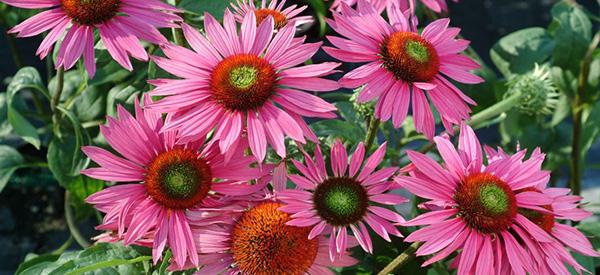
Echinacea
Echinacea, also known as Coneflower or American Coneflower, is a member of the Daisy family and boasts nine distinct species. Many of these flowering and brightly colored plants have found favor and homes in gardens around the world.
However, three species are used for medicinal purposes: Echinacea purpurea, E. pallida, and E. angustifolia. Echinacea purpurea – also called Purple Coneflower – is the most frequently used and the one that has been the subject of a clinical study.
The History of Echinacea
This plant has been part of herbal remedies in North America for centuries. Plains Indians and many other tribes used Echinacea as an analgesic and antiseptic and for a range of conditions from wounds, toothache, poisonous bites and stings, sore throats, and even illnesses such as measles and mumps. There are records dating back to 1762 that describe this herb as a treatment for saddle sores on horses in addition to the various applications for human ailments.
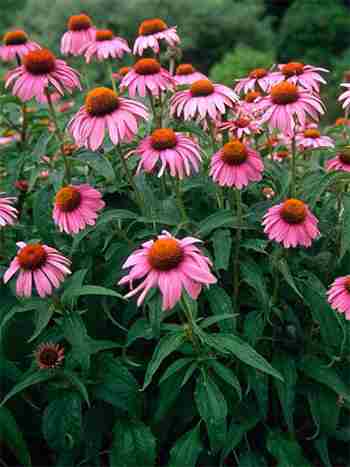
Echinacea was introduced in Europe in about 1890s. Early research was carried out in Germany and the primary value of the plant was identified as its ability to boost the immune system which in turn helps the body fight off infection. Ironically, there is now some tentative evidence that suggests that Echinacea may worsen some autoimmune conditions.
However, this plant has been the subject of several hundred studies. The overwhelming evidence seems to indicate that Echinacea is effective in treating or easing some bacterial infections, viral infections, reducing inflammation, and healing minor wounds. Perhaps it is currently best known as a remedy that eases the symptoms of colds and ‘flu.
Where is Found
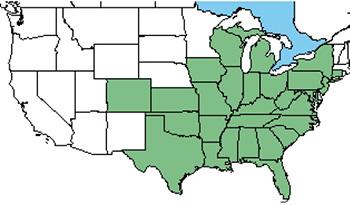 The various species of Echinacea are native to eastern and central North America and are usually found growing in open wooden areas, thickets, and prairies or grasslands. Sadly, this plant is found less and less in the wild due to agricultural and residential expansion into its habitat.
The various species of Echinacea are native to eastern and central North America and are usually found growing in open wooden areas, thickets, and prairies or grasslands. Sadly, this plant is found less and less in the wild due to agricultural and residential expansion into its habitat.
With its surge in popularity in relation to health and the fact that these are attractive and colorful plants that attract a range of pollinators, you can now find Echinacea of various kinds in gardens in many regions including parts of Europe, the UK, and Australia.
How to Identify Echinacea
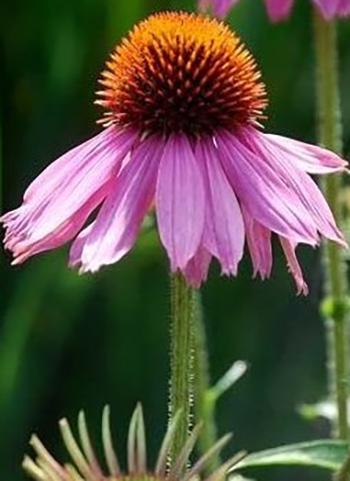
Identifying Echinacea is not too difficult. Equally, the differences in flower color help to identify the different species. For the purposes of this article, we will focus on the most popular and frequently used one: Echinacea purpurea or Purple Coneflower.
This perennial reaches a height of 24 – 40 inches / 60 centimeters – 1 meter, and it forms a compact, small bush.
- Stem: The stems are straight, erect, and unbranched. They are light or pale green with thin, vertical purple lines. The stems are covered with stiff, white hairs. The upper or highest stems terminate in a single flower.
 Leaf: The leaves are a narrow oval shape that tapers to a point as each end. Although they are usually toothed, occasionally leaves have no teeth at all. The teeth are widely spaced. The upper leaf surface is dark green and has sparse, fine white hairs on it. The lower leaves are larger than the ones higher up the plant.
Leaf: The leaves are a narrow oval shape that tapers to a point as each end. Although they are usually toothed, occasionally leaves have no teeth at all. The teeth are widely spaced. The upper leaf surface is dark green and has sparse, fine white hairs on it. The lower leaves are larger than the ones higher up the plant.- Flower: Echinacea produces large flowers that resemble daisies.
However, their structure is different in that the central head is mounded and cone-like, hence the popular name, and produces spines.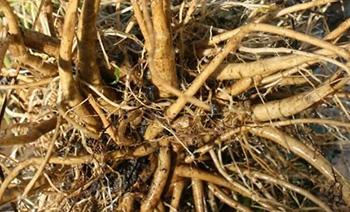
The species Echinacea purpurea, has deep pink petals and a large center. This plant blooms in mid-summer and there may be a second bloom in early fall.
- Root: Each plant develops multiple thick taproots that go deep as the plant matures and grows.

- Seeds: The dried flower cone forms bracts and seeds as it dies off after blooming.
These seeds can be removed easily when the seed head is dry.
Each of these plant parts helps in the identification of Echinacea.
How to Grow Echinacea
Again, the focus will be on E. purpurea although most species enjoy the same or similar growing conditions.
There’s lots of good news. Firstly, they will tolerate most soil types if it’s well-drained, they can cope with dry conditions, they are strong enough not to require support even when in bloom, they are hardy, they clump but don’t spread, and they like both full sun and dappled or partial shade.
The only caution is that these plants can get large and as mentioned the roots can go deep. Therefore, ensure you plant them in a suitable place because they don’t like being moved.
Planting time is spring and fall. There are options:
- Seeds: Although propagating from seed is easy, you will need to store them in a moist cold environment for 4 to 6 weeks before sowing. Seeds should then be sown thickly and lightly covered with soil. It should be noted that plants only flower in the second year.

- Plugs or young plants: You can obtain these online or from a garden center. Use a little compost when planting and water regularly to help the roots establish. Watering can become less frequent as the plants get bigger.
While you could do so, many gardeners don’t recommend dividing Echinacea and propagating this way.
In terms of care, these plants don’t usually require feeding. However, if you notice that there are no flowers or that the leaves are discolored it might be necessary to fertilize rather than simply using compost or mulch.
The flowering season can be extended by deadheading and cutting back to a bud or node. If you leave some blooms to go to seed the birds will thank you and the plant may self-seed and you can plant out the new plants come spring.
Related: 10 Plants That Should Never Be Planted Together (Video)
How to Harvest And Process This Plant
Harvesting Echinacea leaves and flowers are not hard although it involves a couple of steps: removing the material and then processing it. How you do this, and when, depends on what part(s) you want to use.
| Aerial parts | Roots | Seeds |
|---|---|---|
| Wait until the flowers are in full bloom on an established plant. As mentioned, this will only occur in the second year of growth. Don’t harvest flowers that have already begun to fade. Leave those flowers to go to seed. | Don’t harvest roots from plants that are younger than three years old. | Collect the seeds if you want to propagate with them. |
| When you cut the stems, use a sharp pair of scissors or shears and be careful to cut just above a leaf node. The plant will then shoot from that node and continue to grow and be healthy. | Keep in mind, too, that harvesting roots mean that you will need to dig up the entire plant and root ball. This is a strenuous activity thanks to the size, depth, and strength of the roots. | Cut off the seed heads once they have plumped up. |
| If you want to harvest the whole plant, cut the stems off just above the base or crown. Only remove 1/3 of the stems – preferably the thicker, older ones – so that the plant remains healthy and shoots again the following season. | Insert a spade 1 ½ - 2 feet / 46 – 60 centimeters from the base of the plant so you avoid digging into the roots. Push the space in as deeply as you can and work for a circle at this distance around the plant. Free and lift the entire root ball. | Place the cut seed heads into a brown paper bag and shake the bag to shake seeds off. |
| Rinse all the plant material and then remove the leaves and flowers from the stems. If you want to retain everything you can leave the stems etc. intact. | Using your hands, carefully pull the root ball into separate crowns (the area where the root and stem fuse together). If you can’t put them apart use garden shears or scissors. | Spread the seed heads/seeds out on a tray or a shallow box so that they form a single layer. |
| Spread the flowers and leaves / whole stems out on a drying rack or suitable fabric. Alternatively, whole stems can be tied in small bundles and hung with paper bags tied around the flowers to catch falling petals. | Shake all the dirt and debris out and then wash the roots in cold water. Using a garden hose is effective. | Leave them to dry in a warm, well-ventilated area for 4 to 6 weeks. |
| Leave them to dry in a warm, well-ventilated area until they are dry and crunchy to the touch. This should only take 1 – 3 days. | Cut the clean and dried roots into small pieces (¼ inch / ½ centimeter long) and leave them in a warm, well-ventilated area to dry out for about 2 weeks. | Remove the outer layer or husk by rubbing them between your hands or fingers.Leave them to dry fully in a labelled paper bag or envelope. |
Each type of plant material can be stored separately or combined depending on how you will use them. Use airtight jars that are clearly labeled. Ensure that the Echinacea is thoroughly dry before placing it in jars or it will go moldy. Store the jars in a cool and dark area.
What Echinacea is Good For And The Natural Remedies Made From it
Although the root is considered to offer the greatest medicinal value, the aerial parts of the plant are useful too. They are used to produce teas, extracts, tinctures, and salves.
Echinacea’s active ingredients include alkamides, phenolic acids, caffeic acid, rosmarinic acid, and polyacetylenes. These and other ingredients, many of which are antioxidants, are believed to be responsible for the plant’s anti-inflammatory, antibacterial, antiviral, and immune-boosting abilities. As a result, this plant has been used short-term for a plethora of ailments and symptoms:
- Cold and flu symptoms
- Minor wounds and abrasions
- Stings and bites
- Toothache
- Some forms of mild bacterial or viral infections.
Early, non-human research indicates that Echinacea may also, lower blood sugar levels, reduce anxiety, improve skin health, and suppress the growth of certain types of cancer cells. Further research is required before these can be added to this plant’s credits!
Echinacea is readily available and found in tea, capsule, extract, tincture, and salve form.
What Parts of the Plant Are Used in Remedies?
The leaves, petals, and roots are all used in various types of remedies. Stems made be included in some dried Echinacea material in addition to leaves and petals. The flower cone is not often included in recipes and preparations.
A DIY Echinacea Recipe
A salve or ointment made from Echinacea is ideal for the application for a range of skin conditions. Further good news is how easy it is to make in your own home! Here’s how.
Ingredients:
- 1 cup dried Echinacea leaves and flowers
- 1 ½ cup of good quality plant-based oil
- ¼ cup beeswax pellets
- Essential oil (optional).
Use additional beeswax if you want a firmer salve.
Method
Step One – Infuse the oil
- Place the Echinacea in a glass jar
- Pour the oil over the dried plant material
- Ensure all the Echinacea is coated in oil.

Option A:
- Put a lid and label on the jar
- Cover the jar with a brown paper bag
- Place the jar in a place where it will get sun
- Leave the infusion for 6 to 10 weeks
- Shake the jar every couple of days.
Option B:
- Place the jar into a small pot on top of a piece of cloth
- Add water to the pot so the level is 2 inches / 5 centimeters from the top of the jar
- Put the stove on low and leave for 2 to 3 hours

- Check it regularly to ensure the oil does not overheat.
- If you have a crockpot, you could place the jar in it, add water so the level is 2” / 5 centimeters from the top of the jar, set to “Warm”, and leave for 8 hours / overnight instead of using a pot.
- Strain the oil through cheesecloth, kitchen muslin, or a fine-mesh sieve.
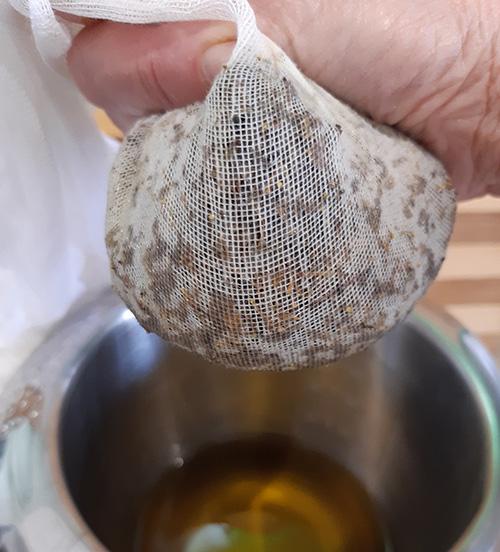
Step Two – Make the salve
- Melt the beeswax pellets:
- Place the infused oil in a double boiler or in a jar or small stainless-steel bowl
- Add the beeswax pellets to the oil

- Place the jar or bowl inside a pot in a few inches of water
- Heat the water slowly over an extremely low heat
- Stir or swirl the mixture until the pellets have all melted.
- Remove the mixture from the heat and allow it to rest for a few seconds
- Carefully pour the hot mixture into jars or tins. We recommend 2 ounce or 50-gram aluminum cosmetic tins, or 4 ounces or 100-gram amber, glass jars.
- Place the lids onto the tin or jar.
- Leave the salve to set for several hours. Do not move the tins or jars during this period.
- Label the salve with the name and the date.
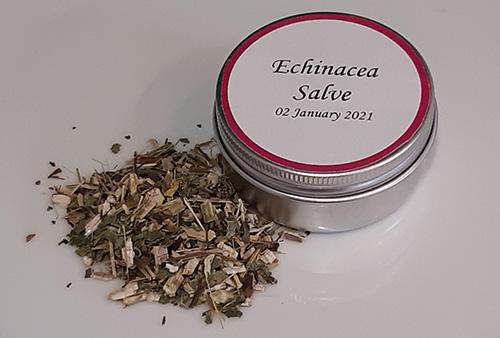
Using Echinacea Salve
Echinacea salve is effective when used topically and short-term for:
- Dry skin, fungal conditions, and rashes: gently rub the salve into the affected skin until it has been absorbed
- Small cuts, wounds, and abrasions: apply a thin layer of salve and cover with a plaster to prevent the salve from rubbing off.

You can apply the salve up to three times a day.
Salve Storage and Shelf-life
A home-made salve should last and remain effective for up to 12 months. It may even have a shelf-life of up to a year if you store it in the fridge. Don’t place the salve where it will get hot as this will damage the consistency.
Dosage
According to a range of sources, Echinacea is most effective if it is taken at high doses for short periods. Long-term or regular use involves much lower amounts or smaller doses. It’s not easy to state a dosage for this herb as it will be affected by: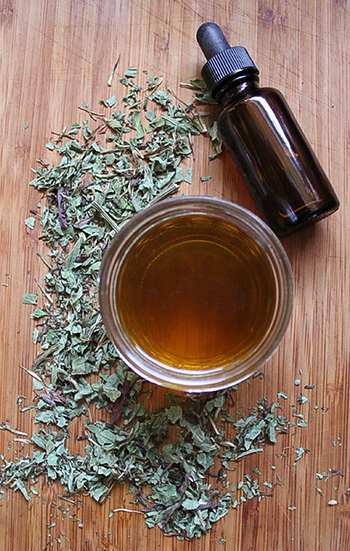
- The individual’s age
- The person’s overall state of health
- What preparation is being used: type and plant part
- Why Echinacea is being taken
Based on studies to date it is thought that the following doses are effective and safe when Echinacea is used short-term. There are still concerns about the long-term use of this plant regardless of the remedy type of what it is used for:
- Tincture: 2 ½ ml / three or maximum four times daily
- Powder: 300 – 500 mg / three times a day.
As a rule, be guided by a healthcare practitioner or the manufacturer’s instructions on the packaging. This applies both to dose size and frequency and to the length of treatment.
What Plants Resemble Echinacea?
The two plants that appear to cause confusion most often are Ratibida and Rudbeckia. Comparing and contrasting theses three will – we hope – help:
| Feature | Echinacea purpurea | Ratibida columnifera | Rudbeckia hirta |
|---|---|---|---|
| Common name | Coneflower / Purple Coneflower | Mexican Hat / Yellow Coneflower | Black-eyed Susan |
| Flowers | |||
| Color | Pink to purple | Yellow and red | Bright yellow |
| Cone | Orange to brown; large, round cone | Brown; very tall cone | Purple to black; domed cone |
| Petals | Daisy-like; curve down and out | Daisy-like; droop down significantly | Daisy-like; extend out |
| Stems | Long, green, hairy, with narrow purple lines | Unbranched and hairy | |
| Size | 24 to 40 inches / 60 cm to 1 meter in height | 2 ½ feet / 76 cm in height | 3 to 4 feet / 91 to 122 cm in height |
| Leaves | Narrow, lanceolate, widely toothed, dark green, slight furring on the upper surface | Narrow, lanceolate, light green, usually toothless, fine hairs | Lanceolate, olive green, mostly toothless, glossy |
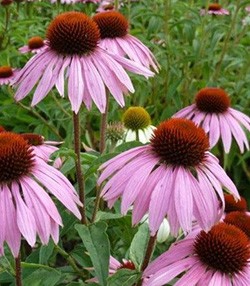 |
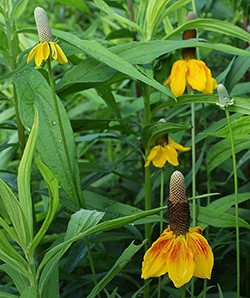 |
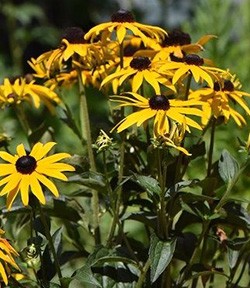 |
Warning and Cautions
Although Echinacea is a plant and remedies made from it are natural, this does not mean that it is completely safe or even suitable for everyone. There are certain individuals or groups of people who should avoid using products that contain this medicinal plant: Children younger than 12 years of age, pregnant and breastfeeding women, diabetics, those on medication for heart problems, patients receiving anti-fungal treatment, patients suffering from auto-immune and immune system disorders/diseases, people allergic to plants in the daisy family (for example asters, dahlias, marigolds, and chrysanthemums to name a few).
There have been some recorded side-effects of using Echinacea, particularly if too much is ingested or if it is taken for too long. Unpleasant side-effects include gastric pain and upset, dizziness, and rashes or hives.
However, it is recommended that if you have an existing medical condition, are on medication, or suffer from plant allergies you check with your medical practitioner before you include Echinacea in any form in your wellness routine or home medicines kit.
You may also like:
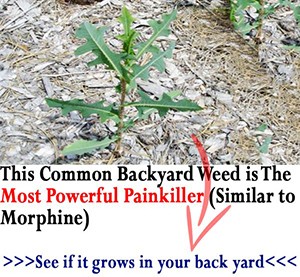 Elderberry Syrup With Echinacea and Goldenseal
Elderberry Syrup With Echinacea and Goldenseal
RedBull of the Woods: The Energy Booster You Can Find in The Wild (Video)
How to Make an Immunity Boosting Shot with Celery, Spinach, Ginger, Lemon, and Manuka Honey






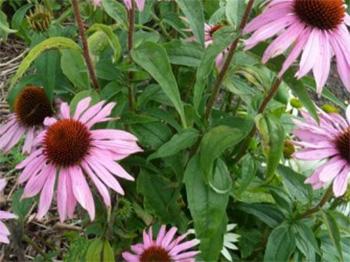 Leaf: The leaves are a narrow oval shape that tapers to a point as each end. Although they are usually toothed, occasionally leaves have no teeth at all. The teeth are widely spaced. The upper leaf surface is dark green and has sparse, fine white hairs on it. The lower leaves are larger than the ones higher up the plant.
Leaf: The leaves are a narrow oval shape that tapers to a point as each end. Although they are usually toothed, occasionally leaves have no teeth at all. The teeth are widely spaced. The upper leaf surface is dark green and has sparse, fine white hairs on it. The lower leaves are larger than the ones higher up the plant.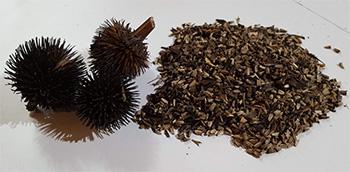
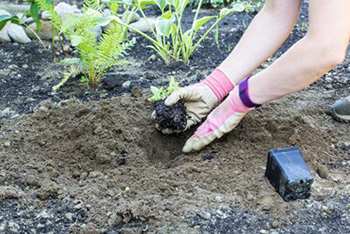
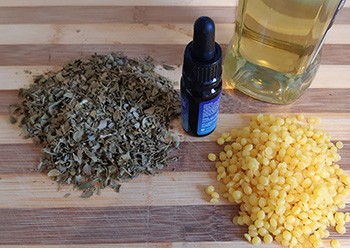
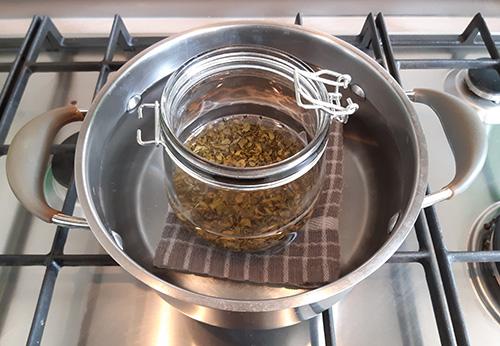
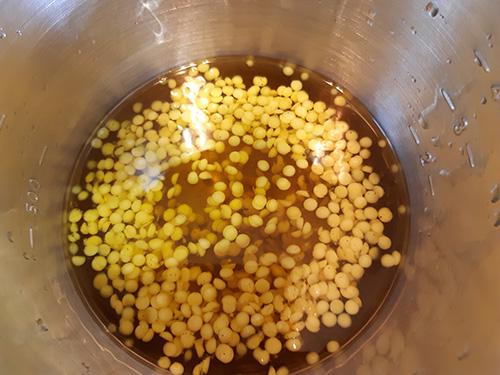

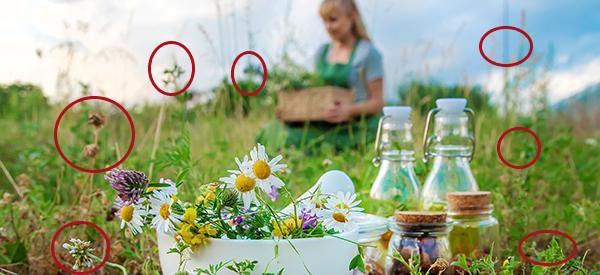
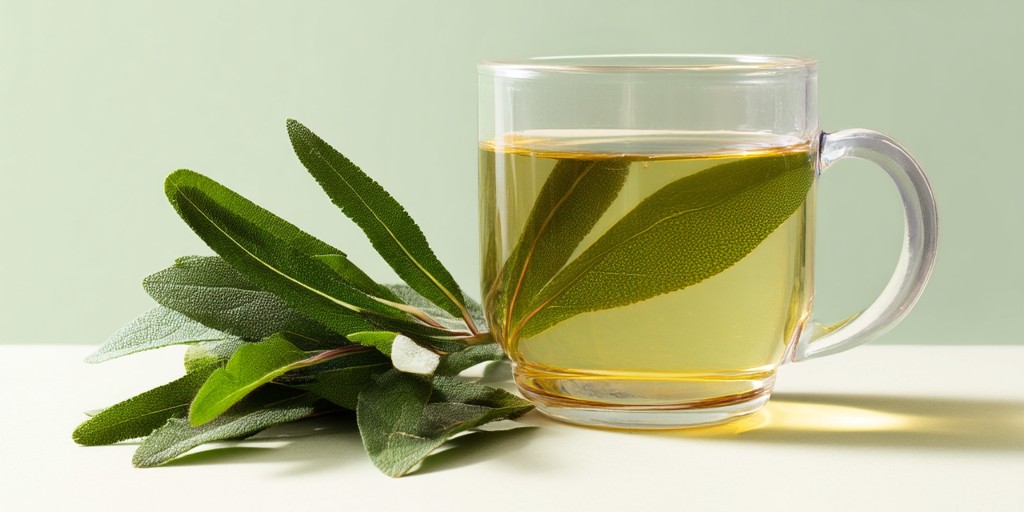
really good article. thank you
I have a friend who noticed that after drinking Ech tea, her Asthma spikes up. Is there a concern for those allergic to daisy?
Hi Dan,
Thank you for your comment.
There are certain individuals or groups of people who should avoid using products that contain this medicinal plant and people allergic to plants in the daisy family are part of it.
God bless!